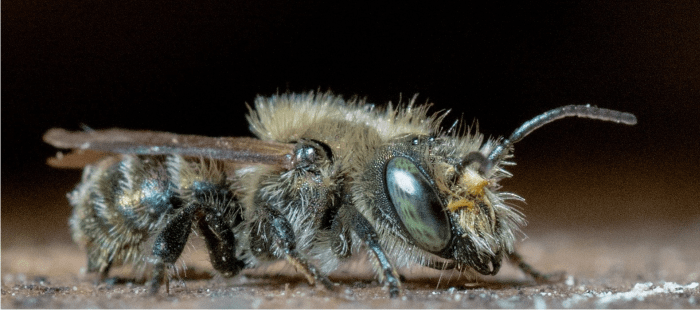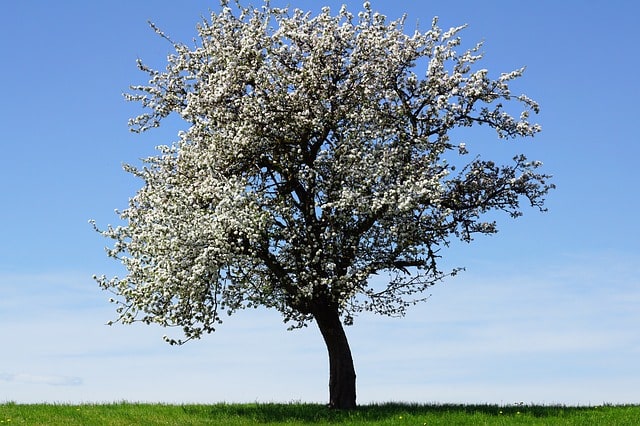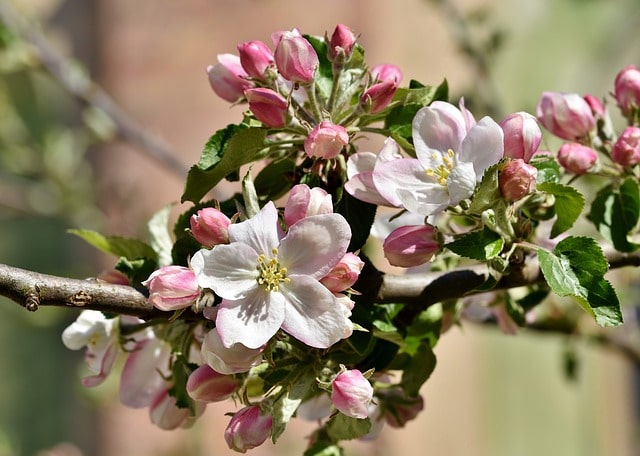Apple honey, or more accurately, apple blossom honey, is not a very common type of honey. It can be found in countries with the biggest apple production. China (where else?) produces approximately half of the total apple production, followed by the United States, Turkey, and Poland. But do they also produce honey in those orchards?
It seems that pollination is a key factor when it comes to apples. This is one place where “Einstein’s 4 years of surviving without bees” makes a lot of sense. Apple trees depend on insect pollination. The rule says that “apple varieties are not self-fertile and will not set a full crop without a compatible pollinizer.”
The apple tree
Malus domestica
The tree is cultivated worldwide and is the most widely grown species in the genus Malus. The tree originated in Central Asia, where its wild ancestor, Malus sieversii, is still found today. Today, there are more than 6000 apple cultivars.
The apple is the core fruit of human existence. In the Old Testament, the apple led to the fall of man; in the New Testament, it represents the redemption from that fall. The apple fell in Newton’s head (sort of saying) so that we can understand physics, Apple is today giving computers and phones… The list is really long.
The apple is a deciduous tree (the opposite of evergreen), growing up to 1.8 to 4.6 m (6 to 15 ft) in cultivation and up to 9.1 m (30 ft) in the wild. When cultivated, the size, shape and branch density are determined by rootstock selection and trimming method. The leaves are alternately arranged dark green-colored simple ovals with serrated margins and slightly downy undersides.
 picture credit JackintheBox – Own work, CC BY-SA 4.0
picture credit JackintheBox – Own work, CC BY-SA 4.0
Flowers:
Flowers appear in spring, simultaneously with the budding of the leaves; blossoms are produced on spurs and some long shoots. The flowers are 3 to 4 cm (1.2 to 1.6 in), white with a pink tinge that gradually fades, have five petals, with an inflorescence consisting of a cyme with 4–6 flowers. The central flower of the inflorescence is called the “king bloom”, it opens first and can develop a larger fruit.
Apples have perfect flowers, meaning both female and male reproductive organs are present, which contain the ovules and produce the pollen, respectively.
The female organ of the flower, the gynoecium, comprises five carpels; each has a stigma, a style and an ovary that normally contains two ovules.
The fruit matures in late summer or autumn, and cultivars exist in a wide range of sizes. A ripe apple can have lots of colors: red, yellow, green, pink, or russetted, even bi- or tri-colored cultivars may be found. The skin may also be wholly or partly russeted (i.e. rough and brown). Unfortunately, today, in order to preserve it for longer, its skin is covered in a protective layer of epicuticular wax. Yeap, all apples.
The flesh of the apple (exocarp) is generally pale yellowish-white, though pink or yellow exocarps also occur.
Pollination:
Coming back to how apple honey is produced, we need to think of pollination first.
This is done in order to set fruit and involves the transfer of pollen (i.e., the male sex cells of higher plants), from the anther to the stigma (i.e. the pollen-receiving part of the female sex organ).
Apples are pollinated by bees, butterflies, flies and other flower-visiting animals. But honey bees are most commonly used.
In commercial orchards, orchard mason bees are also used as supplemental pollinators. Bumblebee queens are sometimes present in orchards, but not usually in sufficient numbers to be significant pollinators.
Top-working bees and side-working bees.
The structure of the apple flower facilitates pollination by top-working bees, as they access the floral nectaries and move through the anthers, where they come into contact with each of the stigmas.
Side-working bees enter through the side of the flower, where they access the nectaries through the base of the anthers. They are less likely to touch the stigma than top-working bees (see Robinson, 1979; Degrandi-Hoffman et al., 1985; Schneider et al., 2002).
Did you know? Apple trees do not grow from seeds.
Propagation of apples as a crop is not from seed, but from grafting, which is an asexual horticultural process where tissues from one plant are inserted into those of another. In this case, the stem is inserted into a suitable rootstock, and the vascular tissues of both components are joined. (The human race’s touch!)
Are apple trees pollinated by honey bees?
There are estimated to be around 20,000 species of bees around the world (Michener, 2007), but only a small proportion are known to pollinate apples. They differ according to apple-growing regions, and within regions of the countries that grow apples. The exception is perhaps the honey bee, Apis mellifera, which is the most important, managed pollinator in the world.
Time.
Honey bees are recommended to be brought into apple orchards because other native bee species may not be present in large enough numbers to achieve adequate pollination. And, of course, this happens because of agricultural chemical practices, which strongly affect local bee communities.
So, honey bee colonies have to be moved into apple orchards for pollination during the flowering period, and then removed from the orchards, to lower the risk of exposure to agricultural chemicals and other management practices following pollination.
Specialists recommend they should be introduced into the orchard when approximately five percent of the apple blossoms have opened (i.e. the king blossoms – the primary or central bud within a cluster that opens first) (Delaplane and Mayer, 2000).
If the hives are placed in orchards too early, that is, before the king blossoms open, bees may use alternative, as in non-crop, flowering plants. It is likely that the bees will return to the apple flowers when they open, because of their overall abundance and quality as a food plant, though the early release of honey bees could, nonetheless, cause a minor diversion of pollination services away from the target apple flowers.
Place.
Then the placement of the hives is also important, depending on the arrangement of apple cultivars and pollinizers within the orchard. The hives should be placed in a slightly elevated position, not directly on the ground, and where there is ample sunlight.
The entrance should be shielded from direct wind and be clear of blockage or obstruction, such as branches or tree trunks, with a direct line to forage resources. The hive entrance should therefore face either into the centre of the orchard or down rows of apple trees. Bees will more likely forage down a row than across rows (Free, 1966).
Do honey bees like apple nectar?
Not quite. Honey bee foraging behavior typically involves floral constancy, which is when pollinating insects concentrate their flower visits to the same plant species for pollen collection, despite there being other available forage resources (Waser, 1986; Waser and Ollerton, 2006; Chittka et al., 1999).
Competition for pollinators may occur when there is a high abundance of many alternative floral resources with overlapping flowering periods in or near apple orchards. It has been shown, that honey bees may forage on ground cover, for example dandelion (Taraxacum officinale) and white clover (Trifolium repens), rather than apple flowers (Free, 1968, 1993; Mayer and Lunden, 1991; MacRae et al., 2009).
This is why it is often recommended or practiced to remove ground flora that is flowering in synchrony with apple (Abrol, 2011). However, it is not always clear if this practice actually increases apple pollination.
But other bees like it.
Mason bees are mostly polylectic (Bosch and Kemp, 2002), but these species have a strong preference for foraging on fruit trees, including apple. Mason bees are solitary, and normally nest in hollow stems and reeds, or previously excavated holes in trees as in tubular cavities (Michener, 2007). Their name comes from to the fact that they normally construct individual nesting cell partitions for each one of their individually laid eggs using mud, or other pliable materials, including masticated leaves.
Mason bees are effective and efficient apple pollinators that are normally active during the early spring, corresponding to the apple flowering period (Park et al., 2012). When visiting apple flowers, they directly contact the stigmas of the flower blossom with the pollen-laden scopa on their abdomens. Finally, mason bees are easily managed or promoted for growers to maintain (see Maeta, 1990).
 ‘mason bee’- picture source pixabay.com
‘mason bee’- picture source pixabay.com
Some mason bee species have been shown to be more effective than honey bees at pollinating apples (see Torchio, 1985; Ladurner et al., 2004; Garratt et al., 2014).
For example, pollination services for 1 acre (0.4 ha) of apple orchard can be fully pollinated by 250 to 500
female Osmia cornifrons, compared to 50 000 honey bees, based on the individual visitation rates of each species. An individual O. cornifrons will visit 15 flowers per minute, which equals 2 450 apple flowers/day, compared to an individual honey bee, which may visit 50 flowers per day (Biddinger et al., 2013).
Similarly, O. lignaria, the Blue Orchard Bee of North America is frequently used for apple pollination (Richards and Kevan, 2002; Sheffield, 2014) and, in Japan, O. cornifrons (Japanese Orchard Bee) is used to pollinate over 80 percent of apples grown in that country. As a result of the success of this pollinator of apple crops, O. cornifrons was introduced to the United States (Maryland) circa 1976 to pollinate apples (Batra, 1979).
Is the apple honey organic?
🙁 No. Agricultural chemicals, such as fertilizers and pesticides, are a significant part of food production, especially at the large scales in which farms operate today. (Current farming practices use vast quantities of water and natural soil nutrients. These practices commonly create ideal circumstances for pest outbreaks. (Hence the use of pesticides.)
There is still a strong reliance on chemicals for food production in most agricultural areas of developed countries, but several management options are available for apple production that can help maintain fruit yield and quality while minimizing the impacts of the chemicals on bees (Reganold et al., 2001).
Nevertheless, organic apple honey is possible.
Organic and Integrated Fruit Production (IFP) offer many benefits over conventional orchard production and are considered to be more ecologically friendly. Integrated Fruit Production is the production of high-quality fruit under ecologically safe methods, where an attempt is made to minimize chemical inputs and obtain the least toxic option (Cross and Dickler, 1994; Sansavini, 1997).
Reganold et al. (2001) compared several criteria of production methods for orchard crops, and found that alternative methods of crop production were comparable, or better, than those of conventional methods. Other studies have supported this finding and have demonstrated that non-conventional methods of production, including organic farming, are typically better for beneficial insects and non-target organisms (see Prokopy, 2003; Peck et al., 2006; Ganie et al., 2013).
The choice of chemicals used is also an important consideration. Application of pesticides should not follow a schedule, but rather be based on the presence or levels of pests (i.e. acceptable thresholds) to reduce the frequency of unnecessary spraying or application.
Certainly, toxic chemicals should never be applied to the target crop during bloom. Bee-friendly products, such as lures or pheromone traps, should always be chosen in preference to chemicals with known and unacceptable toxicity.
Apple nectar composition:
If you want to know the composition of a honey, you have to check the nectar first – says an old beekeeper.
Nectars are aqueous solutions that are secreted by plants to attract and reward animal mutualists. Nectars mainly contain monodisaccharides, and fatty acids, but also have proteins, lipids, phenols, alkaloids and volatile organic compounds (VOCs) – all considered to be good/healthy constituents. However, nectars may also contain bad/unhealthy compounds, such as alkaloids and phenols, commonly associated with herbivore defense.
Fatty acid (FA) in the extracts of flowers of apple:
Palmitic acid: 43.4 mg kg-1
Stearic acid: 1.9 mg kg-1
Linolenic acid: 28.2 mg kg-1
Arachic acid: 1.1 mg kg-1
Total: 74.6 mg kg-1 (a lot more than cherry nectar with 23.2 mg kg-1 and pumpkin nectar, 27 mg kg-1, used as comparison in a recent study).
Composition of the volatile components of the flowers of apple:
Asarone 1.75 mg kg-1 (Content relative to internal standard)
Hexahydrofarnesyl acetone: 1.18 mg kg-1
Phytol: 13.30 mg kg-1
М=1541/: 0.84 mg kg-1
Total: 17.07 mg kg-1
How is apple honey?
First of all it’s rare. It’s one of the first honeys produced in early spring, so beekeepers leave it in the hives for the bees to feed their offspring with. It is said that, at their best, apple orchards can provide a potential of 75 lbs per hive if careful planning has been done by the beekeeper and weather conditions are supportive.
Apple blossom honey has a light golden color and a pleasant and fresh aroma. It does have bold fruity notes and leaves a light apple aftertaste.
Apple honey is not a very sweet honey. Probably this is the reason honey bees are not that attracted to the nectar (not very sweet).
It has a moderately fast crystallization time. (Spring honeys tend to crystallize very quickly.)
Health recommendations:
Raw, unprocessed, and organic apple blossom honey has antibacterial, antioxidant, anti-inflammatory, and diuretic properties. It helps with respiratory tract infections, digestive upset, acne, eczema, and fatigue. All of these are similar to other types of honey’ properties. But because apple honey is so scarce, there have been no studies on its health properties.
If you want things to be more specific, the article What honey is the best for me? can clear things up more.
From where to buy apple honey?
A regular beekeeper knows that producing monofloral apple honey is a tough job. Honey bees will harvest on the other flowers, because they are not fond of apple nectar. Besides, they like this early honey for the bees to eat. Local beekeepers will not sell it.

Amazon sells 100% raw apple blossom honey produced by Sheefa Honey, from local California farms.
Canada produces apple honey from the apple orchards in Southern Ontario. You can find some on thehoneybeestore.ca/.
In the Uk, I found apple honey here: beeworkshoney.co.uk/products/.
When searching for it, remember that it is mostly called ‘apple blossom honey’ and not simple apple honey.
==================
References:
https://en.wikipedia.org/wiki/Apple
Study the Nectars’ Chemical Composition of Apple, Cherry and Pumpkin
A MANUAL ON APPLE POLLINATION, Food and Agriculture Organization of the United Nations


